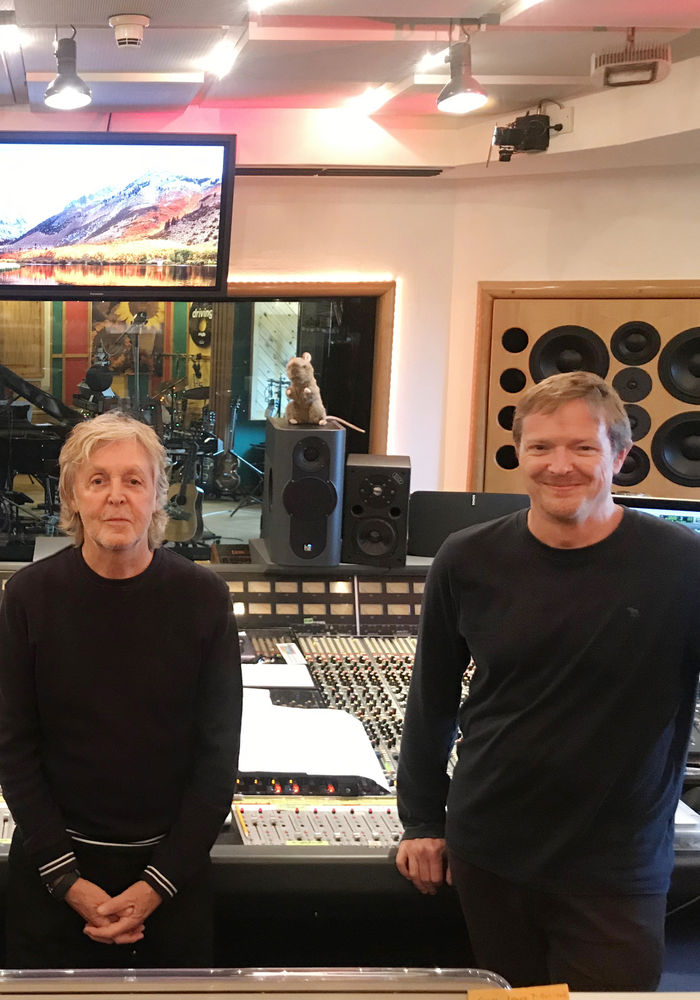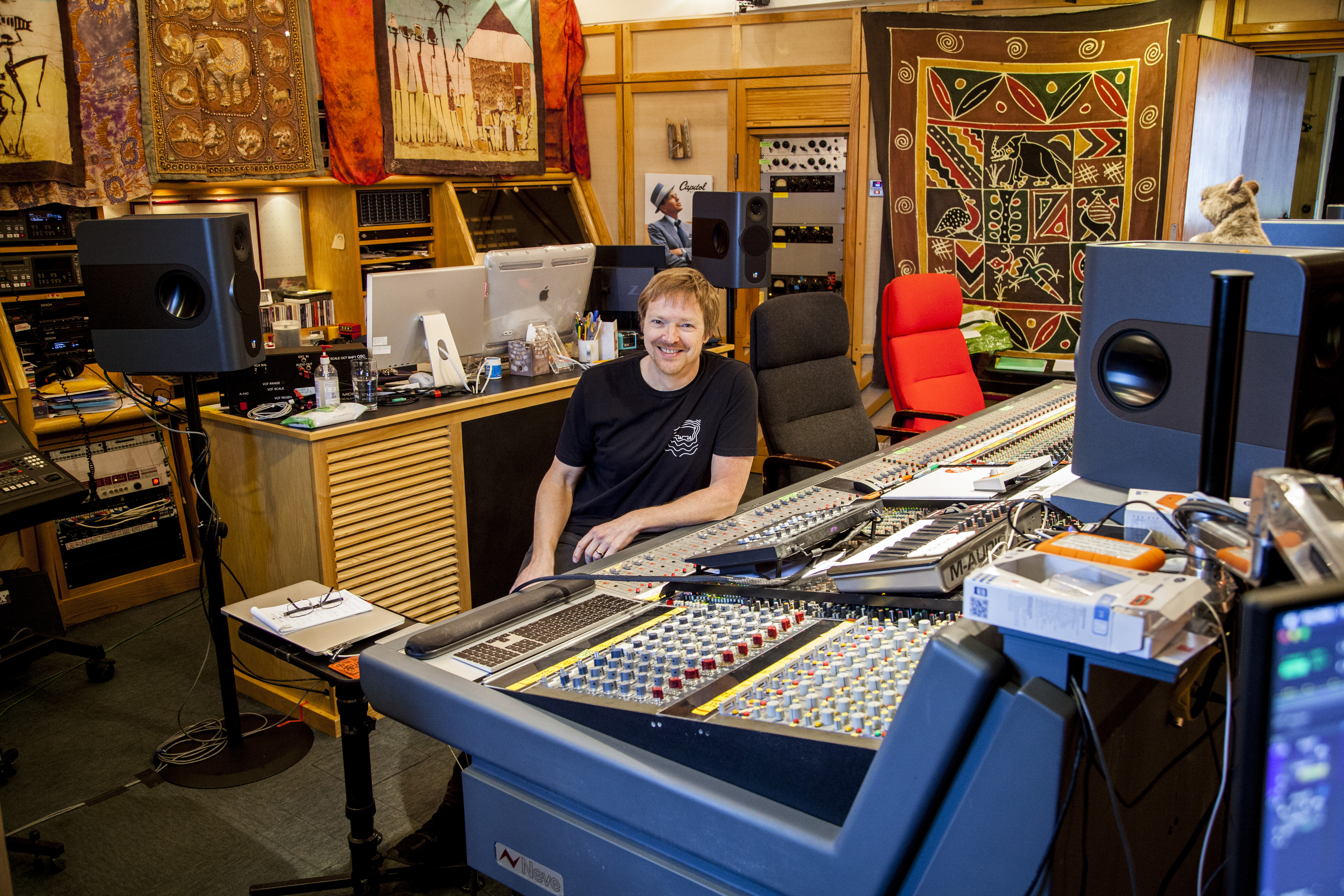Hog Hill Mill
As you can imagine, McCartney’s home studio is full to the brim with an eclectic mix of instruments and production kit, including a huge 60-channel VR60 Neve V Series desk.
“We've recently expanded to 5.1 down here as well, and that's pulled in a bit more equipment,” Orchard grins.
Right after finishing school, he cut his teeth as a runner at PRT Studios, which he remembers had a 1073 Neve studio, followed by a stint at AIR Studios, which features the legendary vintage Neve console, designed in 1977 and destined for AIR’s new facility on the Caribbean island of Montserrat – which Orchard was lucky enough to visit. George Martin was heavily involved with Rupert Neve in the design process of this radical new desk.
“It's just quality, quality sound quality equipment with Neve – it's always well made. It sounds great and it’s always got a nice depth to it. Neve are a firm favourite of mine, I have to say.”
He discloses that when McCartney’s home studio was first built, Klein first used Abbey Road’s very own SSL desk.
“That one went into Studio One at Abbey Road, which was quite controversial at the time,” he recalls. “They ended up having the SSL for a while, but then decided to go for the Neve because it's a bigger, more flexible desk. Paul loves that sound as well, as we all do. It’s a superb desk – the flexibility of the V series when they first brought it out was amazing!
"You can swap anything within the channel as opposed to it being a global mode switch. Whereas with the V series you can swap individual channels and processing, so it's very, very flexible. The desk is absolutely full, and then I've got other preamps set up as well.”
On the V Series desk, McCartney in the past has said: “I'm not technical, I'm hopeless about technical things so I need really good engineers to help me on this. But I know it sounds good, you know? It's got a lot of knobs, a lot of buttons, and it's wonderful."
“Yeah, that's about right really,” Orchard says good naturedly. “He records his demos on his iPhone now though, which is a good step because he used to have a cassette dictaphone. He's entered the digital domain, which is cool! You’ve got to use what you have the best that you can really.
"Down here we've got everything set up on the VR60; I've got things on mic inputs, line inputs, sharing on channels...but thankfully because it's only Paul recording at once, that facilitates a lot more freedom and flexibility with it. So although it's a 60 input desk, it's probably more like 80 inputs because things are on line inputs and mic inputs, and you just locally swap them depending on what's going on.”
Hog Hill Mill is also home to six Neve 1081s and four 1064 vintage modules – some of them feeding directly into Pro Tools as there is no room left on the VR60 – plus a 33609 stereo compressor.
“They've all got their roles – each module and the old 1081s have got a lovely character to them. I think it was in the early ‘90s when we got the V series down here, so I guess it's become vintage now! But it's a bit more precise; you've got a lot more scope with a parametric EQ, whereas the 1081s have more of a fixed band and you have to tune in what frequency you want rather than it be sweepable – and the cues are preset so it gives you different results.
"The preamps sound different when you drive them or overdrive them, which I like to do sometimes because you get a different character – it's like a different instrument, almost.
Orchard is a big fan of the depth of the sound when it comes to the vintage modules:
“They’re a good size too; when you put a mic through those, they sound great. You've got an instant vibe; it's correct and you're not searching for something. It’s all about using things that are going to give you that result – it expedites the whole process. You want the stages of everything as good as possible. So you start with a nice source instrument, a good-sounding guitar, and then a good microphone in the right position into a great preamp with a bit of EQ sometimes, although I tend not to EQ too much.
"I do that as a corrective thing as and when, rather than a default. If you start with that signal chain and that process and get things as good as you possibly can throughout each stage, then you end up with a better result. It always pays off and you end up with a more satisfying recording.”
Orchard adds that he also uses the 33609 compressor on McCartney’s mixes “an awful lot” – particularly as a stereo compressor.
“I use it for recording as my primary thing. It's a favourite stereo compressor, which I love on the piano, on acoustic guitars, on the Rhodes, or whatever we're doing at the time. If something needs a nice bit of controlled, tasty compression, I use it a lot and it's great for extreme compression – that's fairly clean as well. It's just a super useful tool and a firm favorite of mine.”
Orchard also uses two AMS DMX 15-80S stereo microprocessor controlled digital delay lines and an AMS RMX16 reverb unit.
“They're still classics – love them! They've been around for absolutely years. I've always known them to be in studios; they're a familiar piece of kit with a great, classic sound, and we still use them constantly. The AMS delay is great for slapbacks, rather than just being straightforward repeats – there’s a nice tone to it. When you go through the AMS, it's just got something a bit extra about it.”
Hog Hill Mill is also home to 10 original Focusrite ISA 110 mic pre/EQ modules that Rupert Neve designed, which Orchard uses a lot as well.
“They are tremendous-sounding units,” he enthuses. “Rupert designed them when he first left Neve and he started Focusrite – these are from that era. I love them; particularly on drums and on vocals – so I use those very regularly. They've got a nice versatility in the EQ and a lovely broad tone to them. They have that big Neve sound with a similar characteristic to the vintage modules, but slightly different.”
Orchard shares that they were another key part of the McCartney III album:
“They're integral to our set up; I've got a lot of the drums going through them, and I've got the vocal channels going through them, so they played a big role. I always really loved them on bass drums and snare drums and stuff; I used to use them on those at AIR studios as well. They were here before me; I think they've been part of this setup since when the Neve desk was put in. But if I had had the choice, I would have certainly gone for them.”
With 2020 firmly in the rearview mirror, Orchard is grateful for the positive reviews their surprise lockdown project garnered.
“It's brilliant to hear something back and be proud of it. I just love it. It’s always nice to hear that people are enjoying things.”
Any projects (surprises or otherwise) currently in the works?
“Well...there are several things in the pipeline, but I can't say what they are, I'm afraid. We're always busy,” he grins.







